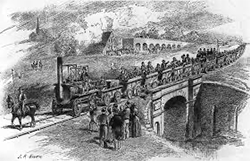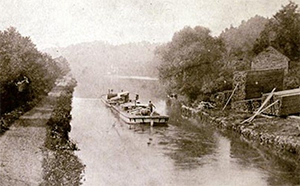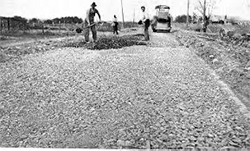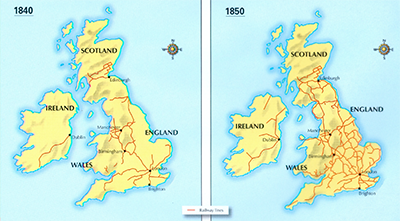|
The Industrial Revolution in Great Britain

Along about the same time, a new kind of road building came about, courtesy of John McAdam. Roads had covered Britain since the time of the Roman occupation, but time and neglect had worsened the conditions of many of those roads. The idea of the turnpike, of charging a toll for using a road, caught on in early in the 18th Century. A hundred years later, McAdam introduced his "macadam" method. The Scottish-born McAdam was in 1816 elected Surveyor-General of roads for the Turnpike Trust, and he set about improving roadways all across the land. His idea centered on the size of the stones used as the road's foundation. For the first two of the three layers of stones, McAdam specified a maximum size of 3 inches; for the top layer, the maximum size was just 1 inch. Workers broke the stones into angle-shaped parts, and a heavy roller compacted the 
The most dynamic innovation in transportation was the railroad. The adoption of new methods to produce more and cheaper iron led to the increased production possibility of iron rails used as tracks by the steam locomotives that pulled the railway carriages of the 19th Century. Richard Trevithick it was in 1802 who built the first steam-powered locomotive, advertising it by driving it down the streets of Camborne in Cornwall. That one didn't have a name. The first commercially successful one did: It was Salamanca, done by John Blenkinsop and Matthew Murray, and it ran for the first time in 1812. Another of the important railway engineers was George Stephenson, whose first locomotive ran in the 1810s. The first public railway, the Stockton and Darlington Railway, Next page > Factories and workers > Page 1, 2, 3, 4, 5 |
|
Social Studies for Kids
copyright 2002–2025
David White



 Transportation was another area improved by the Industrial Revolution. For centuries, people had been transporting themselves and their goods and possessions using roads and waterways. Great Britain was surrounded by water, and ships plied their trade up and down the western and eastern coasts and back and forth along the northern and southern coasts. Interior waterways such as rivers were also used extensively; in addition, the English, Welsh, and Scottish peoples built a large network of canals that facilitated the use of boats pulled by horses or pushed by people. A national canal network existed from 1820 and had a meteoric rise in popularity before the advent of the railroad a few decades later.
Transportation was another area improved by the Industrial Revolution. For centuries, people had been transporting themselves and their goods and possessions using roads and waterways. Great Britain was surrounded by water, and ships plied their trade up and down the western and eastern coasts and back and forth along the northern and southern coasts. Interior waterways such as rivers were also used extensively; in addition, the English, Welsh, and Scottish peoples built a large network of canals that facilitated the use of boats pulled by horses or pushed by people. A national canal network existed from 1820 and had a meteoric rise in popularity before the advent of the railroad a few decades later. stones, effectively knitting them together. The road was sloped slightly, from the middle downward to the sides, with a drainage ditch on each side. The method of building the road became so synonymous with John McAdam that the roads were called macadam roads. The first such road in Britain was Marsh Road at Ashton Gate, Bristol; the year was 1816. Using these roads with increasing frequencies were riders of horses and drivers of carriages, coaches, and wagons.
stones, effectively knitting them together. The road was sloped slightly, from the middle downward to the sides, with a drainage ditch on each side. The method of building the road became so synonymous with John McAdam that the roads were called macadam roads. The first such road in Britain was Marsh Road at Ashton Gate, Bristol; the year was 1816. Using these roads with increasing frequencies were riders of horses and drivers of carriages, coaches, and wagons. with Stephenson as its engineer, opened in 1825. The Liverpool and Manchester Railway opened in 1830; it was the first inter-city railway in the world. Others quickly followed. Construction of railway lines was very high in the 1840s, so much so that by the end of the decade,
with Stephenson as its engineer, opened in 1825. The Liverpool and Manchester Railway opened in 1830; it was the first inter-city railway in the world. Others quickly followed. Construction of railway lines was very high in the 1840s, so much so that by the end of the decade, 
